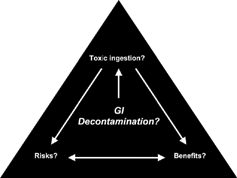To the Editor:
To decontaminate or not? That is the question, asked daily by countless emergency physicians and clinical toxicologists. In a recent review of reported adverse events following single-dose activated charcoal (SDAC), the risk:benefit ratio of this decontamination method was briefly discussed Citation1. The administration of SDAC is often taken lightly; considered by some to be an unavoidable treatment of the poisoned patient or by others, a near miraculous intervention. The statements of the American Academy of Clinical Toxicology and European Association of Poisons Centres on ipecac Citation2, gastric lavage Citation3, SDAC Citation4, cathartics Citation5, and whole bowel irrigation Citation6 clearly stated that gastrointestinal decontamination should not be administered routinely, but this is not always interpreted appropriately Citation1.
Before any gastrointestinal decontamination is performed, emergency physicians often only ask one simple question: Is this a toxic ingestion likely to cause significant effects? If the answer is yes, then gastrointestinal decontamination is performed. For clinical toxicologists and, hopefully, for most emergency physicians, a second question should be asked before gastrointestinal decontamination is performed: Is gastrointestinal decontamination likely to affect the outcome? However, the risk:benefit ratio should also be considered Citation1. Thus, a third question should also be asked before any gastrointestinal decontamination is performed: Given the toxin ingested and the patient status, could gastrointestinal decontamination be harmful? Because of the potential for adverse events associated with all gastrointestinal decontamination methods and the limited evidence suggesting that any affect outcome, I would suggest that this point is as important as the likelihood of affecting the outcome and should be given as much weight in our decision process (). These three questions should not be asked in sequence. If the ingestion is found to be potentially toxic, the risks and the benefits should be carefully considered together before performing any gastrointestinal decontamination.
Because of the nature of toxicology (several xenobiotics and difficulty in performing randomization because risk stratification cannot be done appropriately in most poisonings), we are unlikely to ever have the final answer on the effectiveness of gastrointestinal decontamination. The fact that there is no evidence does not signify absence of efficacy. We simply need to weigh the risk:benefit ratio and be more selective in choosing the patients who are going to receive gastrointestinal decontamination, especially SDAC because this method is administered so frequently. For some substances with high potential for morbidity and mortality, the argument to assume some risk makes sense. However, for most substances that carry an excellent outcome with only supportive treatment, it does not make sense to take risks, especially when the airway can be potentially compromised.
Benoit Bailey
Section of Emergency Medicine
Section of Clinical Pharmacology and Toxicology
Department of Pediatrics
Hôpital Ste-Justine
Montréal, Canada
References
- Seger D. Single-dose activated charcoal—backup and reassess. J Toxicol, Clin Toxicol 2004; 42:101–110.
- Krenzelok E P, McGuigan M, Lheur P. Position statement: ipecac syrup. J Toxicol, Clin Toxicol 1997; 35:699–709. , Available on the web: http://www.clintox.org/Pos_Statements/Ipecac.html (accessed June 2, 2004).
- Vale J A. Position statement: gastric lavage. J Toxicol, Clin Toxicol 1997; 35:711–719. , Available on the web: http://www.clintox.org/Pos_Statements/Gastric_Lavage.html (accessed June 2, 2004).
- Chyka P A, Seger D. Position statement: single-dose activated charcoal. J Toxicol, Clin Toxicol 1997; 35:721–741. , Available on the web: http://www.clintox.org/Pos_Statements/Charcoal.html (accessed June 2, 2004).
- Barceloux D, McGuigan M, Hayden S R. Position statement: cathartics. J Toxicol, Clin Toxicol 1997; 35:743–752. , Available on the web: http://www.clintox.org/Pos_Statements/Charcoal.html (accessed June 2, 2004).
- Tenenbein M. Position statement: whole bowel irrigation. J Toxicol, Clin Toxicol 1997; 35:753–762. , Available on the web: http://www.clintox.org/Pos_Statements/Bowel_Irrigation.html (accessed June 2, 2004).
